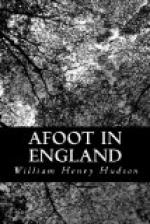Then the storm broke on me, and so fiercely did the rain and sleet thrash me that, fearing a cold soaking, I fled before it to the rim of the plain, where the wheatear had vanished, and saw a couple of hundred yards down on the smooth steep slope a thicket of dwarf trees. It was, the only shelter in sight, and to it I went, to discover much to my disgust that the trees were nothing but elders. For there is no tree that affords so poor a shelter, especially on the high open downs, where the foliage is scantier than in other situations and lets in the wind and rain in full force upon you.
But the elder affects me in two ways. I like it on account of early associations, and because the birds delight in its fruit, though they wisely refuse to build in its branches; and I dislike it because its smell is offensive to me and its berries the least pleasant of all wild fruits to my taste. I can eat ivy-berries in March, and yew in its season, poison or not; and hips and haws and holly-berries and harsh acorn, and the rowan, which some think acrid; but the elderberry I can’t stomach.
How comes it, I have asked more than once, that this poor tree is so often seen on the downs where it is so badly fitted to be and makes so sorry an appearance with its weak branches broken and its soft leaves torn by the winds? How badly it contrasts with the other trees and bushes that flourish on the downs—furze, juniper, holly, blackthorn, and hawthorn!
Two years ago, one day in the early spring, I was walking on an extensive down in another part of Wiltshire with the tenant of the land, who began there as a large sheep-farmer, but eventually finding that he could make more with rabbits than with sheep turned most of his land into a warren. The higher part of this down was overgrown with furze, mixed with holly and other bushes, but the slopes were mostly very bare. At one spot on a wide bare slope where the rabbits had formed a big group of burrows there was a close little thicket of young elder trees, looking exceedingly conspicuous in the bright green of early April. Calling my companion’s attention to this little thicket I said something about the elder growing on the open downs where it always appeared to be out of harmony with its surroundings. “I don’t suppose you planted elders here,” I said.
“No, but I know who did,” he returned, and he then gave me this curious history of the trees. Five years before, the rabbits, finding it a suitable spot to dig in, probably because of a softer chalk there, made a number of deep burrows at that spot. When the wheatears, or “horse-maggers” as he called them, returned in spring two or three pairs attached themselves to this group of burrows and bred in them. There was that season a solitary elder-bush higher up on the down among the furze which bore a heavy crop of berries; and when the fruit was ripe he watched the birds feeding on it, the wheatears among them. The following spring seedlings came up out of the loose earth heaped about the rabbit burrows, and as they were not cut down by the rabbits, for they dislike the elder, they grew up, and now formed a clump of fifty or sixty little trees of six feet to eight feet in height.




